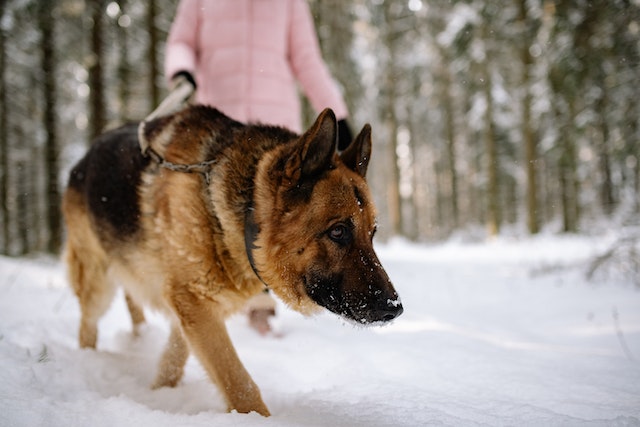How to Prevent Hip Dysplasia in Dogs
Posted: 03/12/2023 | BY: Jenna Bruce | Categories: Dog , Health problems , Pet care
If you’re wondering how to prevent hip dysplasia in dogs, be sure to read this entire blog post as we will cover symptoms, treatment options and preventative measures.
~~~
There’s just something about large breed dogs. Most look fierce and intimidating but are really just pussy cats under all of that height and girth. And it seems like the bigger the dog, the bigger their ability to give us unconditional love.

Sadly, the bigger the dog, the more prone they are to developing hip dysplasia, a painful condition that significantly reduces a dog’s mobility and quality of life. The condition is not only hard on the dog, but heartbreaking for the pup parent to watch.
The good news is by educating yourself about hip dysplasia, you can take preventative measures to keep your dog mobile for as long as possible.
What Is Canine Hip Dysplasia?
Hip dysplasia is a common skeletal condition affecting the hip joint and often seen in large or giant breed dogs, though it can develop in smaller breeds as well. The hip joint in dogs, as in people and most mammals, works as a ball and socket. In dogs with hip dysplasia, the ball and socket either have not developed properly or for some reasons do not fit together properly. This causes them to rub and grind instead of sliding smoothly. Over time, the joint can deteriorate and the dog can have partial or full loss of function and range of motion.
What Causes Hip Dysplasia in Dogs?
There are a variety of factors that can lead to the development of hip dysplasia. The biggest factor by far is genetics. Hip Dysplasia is hereditary and particularly common in larger dogs such as the Great Dane, German Shepherd, and Saint Bernard. Other contributing factors are excessive growth rate as a puppy, types of exercise, improper weight and poor nutrition.
Improper Nutrition
Let’s linger a bit on the topic of nutrition as poor nutrition can have a huge impact on the development of hip dysplasia. As an example, some breeds of puppies require specially formulated foods that help prevent excessive growth, which can lead to hip and elbow dysplasia. The right nutrition helps to slow the growth rate, allowing the puppies’ joints to develop without putting too much strain on them too early.
Obesity puts far too much stress and strain on a dog’s joints, which can cause and exacerbate hip dysplasia. That is why it is so important to follow strict feeding guidelines and avoid giving your pup too many high caloric treats. It’s always a good idea to talk with your vet about the best diet and the right amount of food to feed your pup.
Symptoms of Hip Dysplasia in Dogs

Signs and symptoms of hip dysplasia can show up at any age. Some pups as young as four months old will begin to show signs while many older dogs develop symptoms as they develop osteoarthritis.
In either scenario, there are a handful of symptoms pup parents should be familiar with:
- Decreased activity
- Decreased range of motion
- Difficulty or reluctance rising, jumping, running, or climbing stairs
- Lameness in the hind end
- A “bunny hopping” gait
- Grating in the joint during movement
- Loss of thigh muscle mass
- Pain
- Stiffness or limping
It should be noted that symptoms will vary based on the severity of the disease, the age of the dog, the level of stiffness and inflammation, the degree of looseness of the joint, and how long the pup has suffered with the condition.
Treating Hip Dysplasia in Dogs
The good news is there are quite a few treatment options for hip dysplasia. Surgery is one of the most common options because it offers dramatic and lasting relief. If your dog is not a candidate for surgery for medical or financial reasons, your vet may recommend you make some lifestyle changes. These may include:
- Weightloss to take stress off of the hip joints
- Exercise restriction, especially on hard surfaces
- Physical therapy
- Joint supplements
- Anti-inflammatory medications (nonsteroidal anti-inflammatory drugs, corticosteroids)
- Joint fluid modifiers
If your dog is a good candidate for surgery, you have even more options for pain relief and a second chance at a happy life. Dogs, like people, can have a total hip replacement. This can be a good option for a very young dog who has their whole life in front of them. None of the surgical options are cheap. For instance, the average cost for total hip replacement is $5,500 per hip. If you can afford surgery, however, and your dog is a good candidate, these are your best options for full mobility and a drastic reduction in pain.
How to Prevent Hip Dysplasia in Dogs

While not every case of hip dysplasia can be prevented, there are some steps you can take to reduce your pup’s chance of developing this painful and heartbreaking condition.
To start, work closely with your vet when your pup is young to ensure he is getting the proper nutrition. As we saw, this will help ensure your dog’s skeleton and joints develop at just the right pace.
Next, as your dog grows and matures, be sure to inspire the appropriate levels of exercise. This will continue to protect their joints by keeping obesity at bay.
And finally, if you are in love with a certain dog breed that is prone to hip dysplasia (I have had German Shepherds and Great Danes throughout my life), be sure you do your due diligence and find a responsible breeder that performs regular health screenings on their breeding dogs.
Prognosis for Dogs With Hip Dysplasia
While a diagnosis of hip dysplasia can be devastating, the truth is with proper treatment, dogs with the condition can lead long, full lives. If you suspect your dog may be developing the condition, get them in to see your vet right away. The sooner you treat hip dysplasia, the better the health outcomes will be.

Pet Insurance Can Help You Give Your Pup a Great Life
Let’s face it, hip dysplasia is very expensive to treat. The good news is that most pet insurers will cover the costs of treating genetic conditions like hip dysplasia. But only if the condition isn’t pre-existing. This means you’ve got to enroll your pup as soon as possible to take full advantage of the savings pet insurance offers.
Protect your pet’s health and your wallet from unexpected vet costs by enrolling into a plan ASAP. Get a quote and start comparing plans now.
References:
- “Hip Dysplasia in Dogs,” Retrieved from: https://www.akc.org/expert-advice/health/hip-dysplasia-in-dogs/
- “How to prevent Hip Dysplasia in Your Dog,” Retrieved from: https://wagwalking.com/wellness/how-to-prevent-hip-dysplasia-in-your-dog
- “Hip Dysplasia in Dogs,” https://vcahospitals.com/know-your-pet/hip-dysplasia-in-dogs
The information contained on this blog is intended for informational and educational purposes only and should not be construed as medical advice. It is not a substitute for professional veterinary care. Always consult with your veterinarian before making any changes to your pet's health care or treatment plan.
The authors of this blog are not veterinarians and do not claim to be experts in pet health. The information provided here is based on our own experiences and research, as well as information from reputable sources. However, we cannot guarantee the accuracy or completeness of this information.
We encourage you to do your own research and consult with your veterinarian before making any decisions about your pet's health.
Previous post
Vet Appointment Costs: What You Need to KnowCompare top pet insurance providers plans.
Enter your dog’s age in years and months to calculate their age equivalent to human years.
Calculate your dog’s ageEnter your cat’s age in years and months to calculate their age equivalent to human years.
Calculate your cat’s age